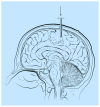Delivery of local therapeutics to the brain: working toward advancing treatment for malignant gliomas
- PMID: 25853310
- PMCID: PMC4696051
- DOI: 10.4155/tde.14.114
Delivery of local therapeutics to the brain: working toward advancing treatment for malignant gliomas
Abstract
Malignant gliomas, including glioblastoma and anaplastic astrocytomas, are characterized by their propensity to invade surrounding brain parenchyma, making curative resection difficult. These tumors typically recur within two centimeters of the resection cavity even after gross total removal. As a result, there has been an emphasis on developing therapeutics aimed at achieving local disease control. In this review, we will summarize the current developments in the delivery of local therapeutics, namely direct injection, convection-enhanced delivery and implantation of drug-loaded polymers, as well as the application of these therapeutics in future methods including microchip drug delivery and local gene therapy.
Figures



Similar articles
-
Current status of local therapy in malignant gliomas--a clinical review of three selected approaches.Pharmacol Ther. 2013 Sep;139(3):341-58. doi: 10.1016/j.pharmthera.2013.05.003. Epub 2013 May 18. Pharmacol Ther. 2013. PMID: 23694764 Review.
-
Overcoming the blood-brain tumor barrier for effective glioblastoma treatment.Drug Resist Updat. 2015 Mar;19:1-12. doi: 10.1016/j.drup.2015.02.002. Epub 2015 Mar 6. Drug Resist Updat. 2015. PMID: 25791797 Review.
-
Targeted Local Therapy for Management of Intracranial High-Grade Gliomas.Prog Neurol Surg. 2018;32:159-171. doi: 10.1159/000469688. Epub 2018 Jul 10. Prog Neurol Surg. 2018. PMID: 29990982 Review.
-
Novel therapies for malignant gliomas: a local affair?Neurosurg Focus. 2006 Apr 15;20(4):E9. Neurosurg Focus. 2006. PMID: 16709040 Review.
-
Endovascular therapies for malignant gliomas: Challenges and the future.J Clin Neurosci. 2016 Apr;26:26-32. doi: 10.1016/j.jocn.2015.10.019. Epub 2016 Feb 5. J Clin Neurosci. 2016. PMID: 26857294 Review.
Cited by
-
Focused ultrasound-mediated delivery of viral neuronal tracers in marmosets.Cell Rep Methods. 2024 Feb 26;4(2):100719. doi: 10.1016/j.crmeth.2024.100719. Cell Rep Methods. 2024. PMID: 38412835 Free PMC article.
-
Hyaluronic acid based low viscosity hydrogel as a novel carrier for Convection Enhanced Delivery of CAR T cells.J Clin Neurosci. 2018 Oct;56:163-168. doi: 10.1016/j.jocn.2018.06.005. Epub 2018 Jul 21. J Clin Neurosci. 2018. PMID: 30041899 Free PMC article.
-
Immunotherapy for glioblastoma: current state, challenges, and future perspectives.Cell Mol Immunol. 2024 Dec;21(12):1354-1375. doi: 10.1038/s41423-024-01226-x. Epub 2024 Oct 15. Cell Mol Immunol. 2024. PMID: 39406966 Free PMC article. Review.
-
Nanomedicine in Clinical Photodynamic Therapy for the Treatment of Brain Tumors.Biomedicines. 2022 Jan 3;10(1):96. doi: 10.3390/biomedicines10010096. Biomedicines. 2022. PMID: 35052776 Free PMC article. Review.
-
T cell immunotherapy enhanced by designer biomaterials.Biomaterials. 2019 Oct;217:119265. doi: 10.1016/j.biomaterials.2019.119265. Epub 2019 Jun 14. Biomaterials. 2019. PMID: 31271861 Free PMC article. Review.
References
-
- Tait MJ, Petrik V, Loosemore A, Bell BA, Papadopoulos MC. Survival of patients with glioblastoma multiforme has not improved between 1993 and 2004: analysis of 625 cases. Br J Neurosurg. 2007;21(5):496–500. - PubMed
-
- Chaichana K, Zamora-Berridi G, Camara-Quintana J, Quinones-Hinojosa A. Neurosphere assays: growth factors and hormone differences in tumor and nontumor studies. Stem Cells. 2006;24(12):2851–2857. - PubMed
Publication types
MeSH terms
Substances
Grants and funding
LinkOut - more resources
Full Text Sources
Other Literature Sources
Medical
Research Materials
